FMVSS 302汽车内饰材料阻燃
fmvss302测试标准
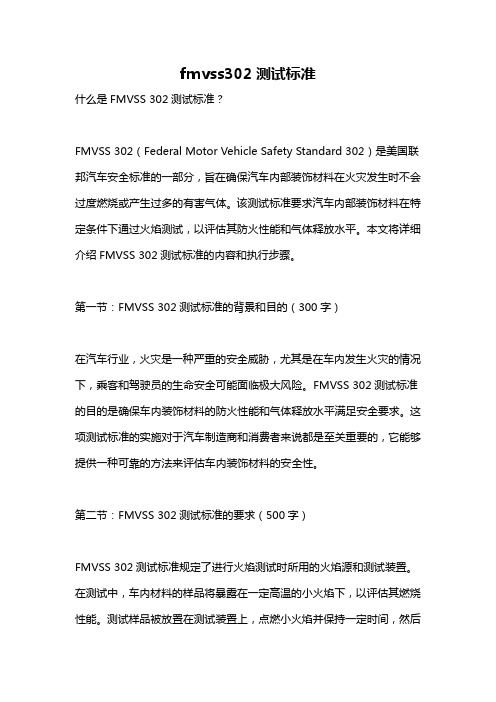
fmvss302测试标准什么是FMVSS 302测试标准?FMVSS 302(Federal Motor Vehicle Safety Standard 302)是美国联邦汽车安全标准的一部分,旨在确保汽车内部装饰材料在火灾发生时不会过度燃烧或产生过多的有害气体。
该测试标准要求汽车内部装饰材料在特定条件下通过火焰测试,以评估其防火性能和气体释放水平。
本文将详细介绍FMVSS 302测试标准的内容和执行步骤。
第一节:FMVSS 302测试标准的背景和目的(300字)在汽车行业,火灾是一种严重的安全威胁,尤其是在车内发生火灾的情况下,乘客和驾驶员的生命安全可能面临极大风险。
FMVSS 302测试标准的目的是确保车内装饰材料的防火性能和气体释放水平满足安全要求。
这项测试标准的实施对于汽车制造商和消费者来说都是至关重要的,它能够提供一种可靠的方法来评估车内装饰材料的安全性。
第二节:FMVSS 302测试标准的要求(500字)FMVSS 302测试标准规定了进行火焰测试时所用的火焰源和测试装置。
在测试中,车内材料的样品将暴露在一定高温的小火焰下,以评估其燃烧性能。
测试样品被放置在测试装置上,点燃小火焰并保持一定时间,然后观察样本是否燃烧并记录相关数据。
FMVSS 302标准对于乘用车和轻型卡车都有明确的要求。
根据FMVSS 302标准的规定,内装饰材料必须在火焰点燃后的一定时间内自行熄灭,不得继续燃烧。
同时,标准还对材料在燃烧过程中产生的气体释放进行了限制,确保释放的有害气体低于特定的阈值。
第三节:FMVSS 302测试标准执行步骤(700字)执行FMVSS 302测试标准需要进行以下步骤:1.准备测试样品:从要测试的汽车内部装饰材料中切取适当大小的样本。
这些样本通常是贴合汽车内饰的表面材料,如座椅面料、车顶衬布等。
确保样品的尺寸和形状符合标准的要求。
2.测试设备准备:安装测试装置,并确保其符合FMVSS 302测试标准的要求。
fmvss302阻燃标准和ul
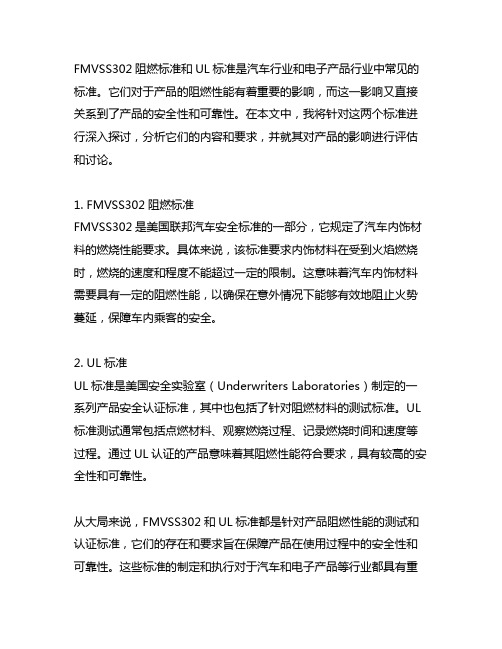
FMVSS302阻燃标准和UL标准是汽车行业和电子产品行业中常见的标准。
它们对于产品的阻燃性能有着重要的影响,而这一影响又直接关系到了产品的安全性和可靠性。
在本文中,我将针对这两个标准进行深入探讨,分析它们的内容和要求,并就其对产品的影响进行评估和讨论。
1. FMVSS302阻燃标准FMVSS302是美国联邦汽车安全标准的一部分,它规定了汽车内饰材料的燃烧性能要求。
具体来说,该标准要求内饰材料在受到火焰燃烧时,燃烧的速度和程度不能超过一定的限制。
这意味着汽车内饰材料需要具有一定的阻燃性能,以确保在意外情况下能够有效地阻止火势蔓延,保障车内乘客的安全。
2. UL标准UL标准是美国安全实验室(Underwriters Laboratories)制定的一系列产品安全认证标准,其中也包括了针对阻燃材料的测试标准。
UL 标准测试通常包括点燃材料、观察燃烧过程、记录燃烧时间和速度等过程。
通过UL认证的产品意味着其阻燃性能符合要求,具有较高的安全性和可靠性。
从大局来说,FMVSS302和UL标准都是针对产品阻燃性能的测试和认证标准,它们的存在和要求旨在保障产品在使用过程中的安全性和可靠性。
这些标准的制定和执行对于汽车和电子产品等行业都具有重要的意义,有利于提升产品质量,保护消费者的权益。
在我看来,FMVSS302阻燃标准和UL标准的重要性不言而喻。
作为消费者,我们每天都会接触并使用各种各样的产品,而这些产品的阻燃性能直接关系到了我们的生命财产安全。
厂商应该严格遵守这些标准要求,确保产品的阻燃性能符合标准,以提供给消费者更加安全可靠的产品。
FMVSS302阻燃标准和UL标准对于产品的阻燃性能有着重要的影响,而这一影响直接关系到产品的安全性和可靠性。
厂商和消费者都应该高度重视这些标准,共同致力于提升产品的质量和安全性。
希望通过本文的阐述,你能够对FMVSS302阻燃标准和UL标准有更深入的了解,从而在日常生活中更加关注产品的阻燃性能,提高自身的安全意识。
MVSS302汽车内饰材料的燃烧特性标准
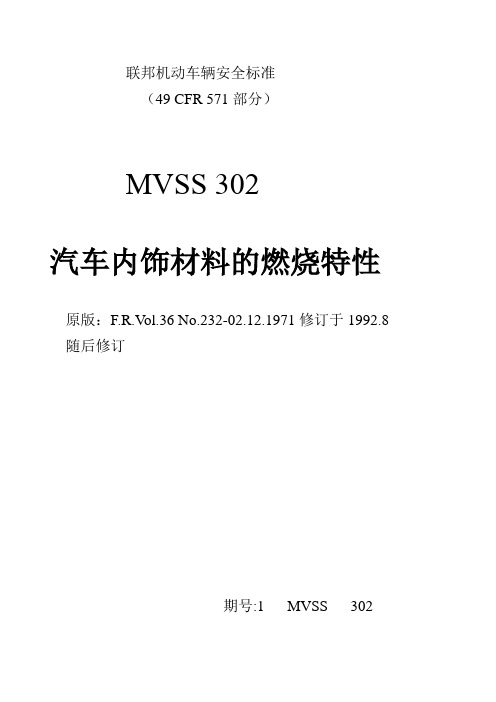
联邦机动车辆安全标准(49 CFR 571部分)MVSS 302汽车内饰材料的燃烧特性原版:F.R.V ol.36 No.232-02.12.1971修订于1992.8 随后修订期号:1 MVSS 302国家:U.S.A原版:F.R.V ol.36No.232-02.12.1971§571.302 标准No.302;汽车内饰材料的燃烧特性S1. 范围本标准指定了用于汽车内舱材料的抗燃性要求。
S2. 目的本标准的目的是为了减少因汽车起火特别是由于汽车内部因火柴或香烟所引起的起火而引起的伤亡。
S3. 应用本标准适用于轿车、多用途轿车、卡车和公共汽车。
S3A. 定义车内气室即汽车内舱内盛满新鲜空气的部分。
S4 要求S4.1 S4.2部分所描述的以下汽车内舱部分与S4.3部分的要求是一致的,汽车坐垫、座椅靠背、安全带、顶蓬、扶手、所有装饰性衬板包括门前、门后和侧边面板、搁板、弹性头垫、地板、遮阳板、窗帘、遮阳物、车轮外罩、发动机罩,垫罩和其他任何室内材料包括撞车时吸收碰撞能量的填料、缓冲装置等材料。
S4.1.1 [保留]S4.2 位于内舱气室的1/2英寸的单一材料或层积复合材料的任何部分应满足S4.3部分的要求。
S4.2.1完全不与其他材料相连接的材料在单独试验时应满足S4.3.S4.2.2 与其他材料完全相连接的材料在作为层积复合材料试验时应满足S4.3的要求。
见I83的示例说明。
材料A和B之间的分界面未粘接,材料A应单独进行试验,位于内舱气室的B材料厚度在1/2英寸内,材料B和材料C紧密结合,因此B和C是作为层积复合材料,切取材料C如图所示,厚度为1/2英寸。
S4.3 (a)当按S5试验时,S4.1和S4.2所描述的材料不会燃烧,也不会使火焰前端以4英寸每分钟的速度通过其表面。
无论如何,集中火焰前端的传递不适用于按照S5试验所切割的样品。
(b)如果材料从试验计时开始,60s内停止燃烧,且从开始计时点处的燃烧距离不大于2英寸,被认为满足S4.3(a)的燃烧速率要求。
内饰燃烧标准

内饰燃烧标准
内饰燃烧标准是指对于汽车、飞机、船舶等交通工具内饰材料燃烧性能的规范化管理。
这些材料包括座椅、仪表板、车门内板、天棚、地毯、内饰面料等。
由于内饰材料在车辆事故或其他火灾事件中可能会引发大火,因此内饰燃烧标准越来越受到关注。
世界各国都制定了不同的内饰燃烧标准,其中最常用的是美国的FMVSS 302、欧洲的ECE R118和中国的GB 8410。
这些标准主要测试内饰材料在明火下的燃烧性能,如燃烧速率、火焰扩散速度和烟雾产生量等。
内饰燃烧标准的实施可以有效降低车辆火灾事故的发生率,保障车上乘客的安全。
同时,符合标准的内饰材料也能提高车辆整体的质量和安全性。
因此,对于生产和销售内饰材料的公司来说,遵守内饰燃烧标准是一项必要的责任和义务。
- 1 -。
fmvss302 1998阻燃标准

fmvss302 1998阻燃标准
FMVSS 302是美国联邦机动车辆安全标准FMVSS 302-1998,关于车辆座椅、座椅固定装置、头枕、安全带和ISOFIX儿童约束系统的阻燃要求。
该标准中,对试样不燃烧,或火焰在样品上水平燃烧的速度不超过102毫米每秒。
当样品表面是切割出来的,则这个判定要求不适用于测试该表面火焰水平燃烧速度。
从测试计时开始,若样品燃烧的时间不到60秒就停止燃烧了,且从计时开始那个位置起,样品的损毁长度没有超过51毫米,则认为其满足FMVSS302的要求。
以上信息仅供参考,如需了解更多最新信息,建议咨询专业人士。
fmvss302阻燃标准解读

FMVSS302阻燃标准解读随着社会的进步和科技的发展,人们对于汽车的安全性能要求越来越高。
而汽车作为一种常用的交通工具,在发生火灾事故时,阻燃材料的使用将对车辆内部的人员和财产带来重要的保护作用。
FMVSS302阻燃标准成为了衡量汽车内饰材料阻燃性能的重要指标。
为了更好地了解FMVSS302阻燃标准,本文将结合相关资料对其进行深入解读。
一、FMVSS302阻燃标准概述1.1、FMVSS302是什么FMVSS302是美国联邦汽车安全标准局(NHTSA)制定的汽车内饰材料阻燃标准,全称为Federal Motor Vehicle Safety Standard No.302。
该标准要求汽车内部使用的材料在火焰接触后具有一定的阻燃性能,以降低火灾事故对车辆内部人员和财产带来的损失。
该标准适用于乘用车和商用车等各类汽车。
1.2、FMVSS302的要求根据FMVSS302标准的相关规定,被测样品在接触明火后不能持续燃烧时间超过60秒,燃烧速度不能超过102mm/分钟,不能滴落熔融物,也不能出现燃烧程度大于100mm的情况。
FMVSS302还对被测材料的燃烧后烟雾产生量进行了明确的要求。
这些严格的要求确保了被覆盖在汽车内部的材料具有较好的阻燃性能,能在火灾发生时有效地减缓火势蔓延,提供逃生和灭火的时间窗口。
二、FMVSS302阻燃标准的意义2.1、保障汽车乘员安全FMVSS302阻燃标准的实施,使得汽车内部使用的材料能够在火灾发生时起到阻燃的作用,延缓火势蔓延,为乘员逃生争取宝贵的时间。
这对于保障汽车乘员的生命安全具有非常重要的意义。
2.2、减少火灾事故损失遵循FMVSS302阻燃标准要求的汽车内饰材料具有较好的阻燃性能,一旦发生火灾事故,能够有效地减少火势蔓延的速度,减少火灾事故带来的财产损失。
2.3、提升汽车制造质量在汽车制造过程中严格遵循FMVSS302阻燃标准要求的执行,有助于提升汽车整车的品质和安全性能,提升汽车制造企业的竞争力。
汽车内饰物燃烧标准

汽车内饰件阻燃标准等级汽车内饰阻燃标准主要由国家或汽车制造商发布,其中大部分标准的测试方法都是比较接近,主要关注内饰材料的易燃性和燃烧速率,只要不超过一定的燃烧速率(一般为102mm/min)时,都是允许在汽车内使用的。
取样测试的部位为汽车内暴露面向下13mm内的单层或者复合层材料,若每层可以分离则需要单独测试。
内饰材料燃烧标准GB8410 - 汽车内饰材料的燃烧特性。
GB8410标准规定了汽车内饰材料水平火钳特性的技术要求及试验方法。
GB8410标准适用于汽车内饰材料水平燃烧特性的评定。
内饰材料不燃烧、可以燃烧但燃烧速度不大于100mm/min、火焰在60s内自行熄灭且燃烧距离不大于50mm。
燃烧速度:测得的燃烧距离与燃烧此距离所用时间的比值,单位为毫米每分钟(mm/min)。
从保证乘员安全的角度来讲,不燃烧当然是最好,而燃烧速度能够靠材料本身保证在一定的范围之内,也可以为乘员提供一定的生存时间和逃生的时间。
在实际的试验操作过程中,是以在规定时间内不能引燃或在第一个标志柱之前自行熄灭的视为不燃烧。
汽车内饰材料阻燃标准FMVSS302主要适用于汽车内饰材料的阻燃测试,UL94是广泛适用于塑料材料的阻燃测试。
针对产品用途范围不一样,且测试方法和要求也不一样。
不易燃。
医用防护服采用不易燃材料,并且离开火焰后燃烧不大于5s,该项目可以采用ZYYQ阻燃性能测试仪设备进行测试,ZYYQ阻燃性能测试仪智能化程度高,符合国家标准GB/T5455-1997《纺织品燃烧性能试验垂直法》,可用于有阻燃要求的服装织物、装饰织物、帐篷织物等阻燃性能的测定。
阻燃海绵由于含可燃的碳氢链段、密度小、比表面积大,未经阻燃处理的聚氨酯海绵是可燃物,遇火会燃烧并分解,产生大量的烟雾,给灭火带来困难。
特别是聚氨酯软泡开孔率较高,可燃成分多,燃烧时由于较高的空气流通性而源源不断地供给氧气,易燃且不易自熄。
聚氨酯海绵的许多应用领域非常广泛,如建筑材料、床垫、家具、保温材料、汽车座垫及内饰材料等,都需达到阻燃要求。
FMVSS302 中文标准
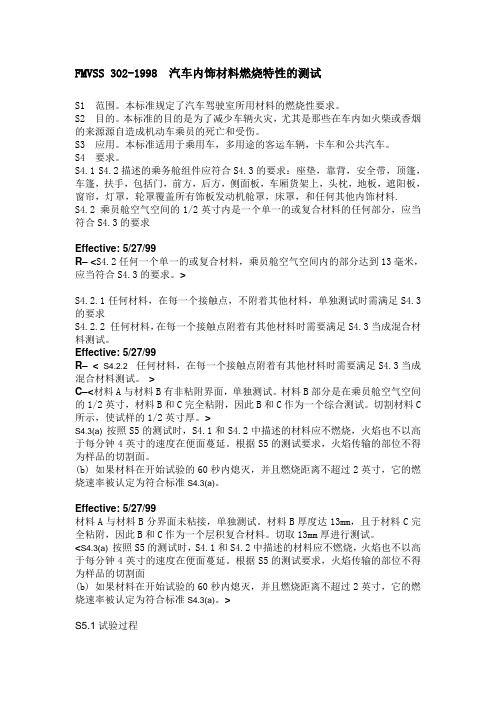
FMVSS 302-1998 汽车内饰材料燃烧特性的测试S1 范围。
本标准规定了汽车驾驶室所用材料的燃烧性要求。
S2 目的。
本标准的目的是为了减少车辆火灾,尤其是那些在车内如火柴或香烟的来源源自造成机动车乘员的死亡和受伤。
S3 应用。
本标准适用于乘用车,多用途的客运车辆,卡车和公共汽车。
S4 要求。
S4.1 S4.2描述的乘务舱组件应符合S4.3的要求:座垫,靠背,安全带,顶篷,车篷,扶手,包括门,前方,后方,侧面板,车厢货架上,头枕,地板,遮阳板,窗帘,灯罩,轮罩覆盖所有饰板发动机舱罩,床罩,和任何其他内饰材料.S4.2 乘员舱空气空间的1/2英寸内是一个单一的或复合材料的任何部分,应当符合S4.3的要求Effective: 5/27/99R– <S4.2任何一个单一的或复合材料,乘员舱空气空间内的部分达到13毫米,应当符合S4.3的要求。
>S4.2.1任何材料,在每一个接触点,不附着其他材料,单独测试时需满足S4.3的要求S4.2.2 任何材料,在每一个接触点附着有其他材料时需要满足S4.3当成混合材料测试。
Effective: 5/27/99R–< S4.2.2 任何材料,在每一个接触点附着有其他材料时需要满足S4.3当成混合材料测试。
>C–<材料A与材料B有非粘附界面,单独测试。
材料B部分是在乘员舱空气空间的1/2英寸,材料B和C完全粘附,因此B和C作为一个综合测试。
切割材料C 所示,使试样的1/2英寸厚。
>S4.3(a) 按照S5的测试时,S4.1和S4.2中描述的材料应不燃烧,火焰也不以高于每分钟4英寸的速度在便面蔓延。
根据S5的测试要求,火焰传输的部位不得为样品的切割面。
(b) 如果材料在开始试验的60秒内熄灭,并且燃烧距离不超过2英寸,它的燃烧速率被认定为符合标准S4.3(a)。
Effective: 5/27/99材料A与材料B分界面未粘接,单独测试。
绿色工业背景下汽车材料阻燃要求及应用现状分析

绿色工业背景下汽车材料阻燃要求及应用现状分析摘要:随着全球经济一体化的不断深化,节能减排已成为当下工业领域的重要课题,汽车行业的快速发展也加快了市场内卷,在汽车工业上面临着节能、环保、舒适等高要求,同时对材料的阻燃性能要求也越来越高。
材料作为汽车构成中的重要基础,要解决这一问题,就要了解目前汽车工业材料阻燃及相关技术。
基于此,文章首先对汽车用材料的主要类型和应用现状进行分析,之后详细阐述汽车产业的发展对材料阻燃的要求,旨在为提高汽车材料安全性和阻燃性能方面进行行业交流与实践借鉴。
关键词:汽车工业;阻燃材料;创新技术;现状问题。
现如今,汽车已经成为人们生活和工作中重要的交通工具,在工业科技不断进步的推动下,人们对汽车的应用要求也日趋多元化,现如今的汽车材料也悄然发生了变化。
由于车辆空间小、内饰材料易燃等特点,一旦车辆发生自燃事故,很难控制火势,往往危及车上乘客的生命安全及财物安全。
因此,汽车材料必须要有很好的延烧和阻燃性能,为驾乘人员提供更多的安全保障。
尤其是当下各类新能源动力组合的汽车不断涌现,汽车制造工艺的创新和迭代对汽车材料的使用要求和阻燃性能也变得更加严格,对加快汽车行业的良性发展发挥了重要作用。
一、汽车材料的主要分类及应用现状1.1金属材料目前金属材料仍在汽车制造中占据着主导地位,主要是车身骨架、覆盖板、保险杠、发动机、汽车底盘等零部件的制造材料,约占汽车整车重量的60%—80%。
常见的汽车金属材料有钢铁、铝合金、镁合金,锌合金,钛合金等金属材料。
铸铁或碳素钢是制造汽车结构零部件的关键材料,例如汽车车身;合金钢材料在制造功能性汽车零部件等方面优势明显,如十字轴、传动轴、弹簧、空气压缩机等。
另外一些其他金属材料在汽车制造中也发挥着不可替代的作用,比如新能源汽车的车身材料、轮毂、电池系统、覆盖板、热交换器、保险杠等处的材料为铝合金,而钛合金是制造汽车弹性元件的重要支撑。
1.2非金属材料汽车制造中的非金属材料主要包括:(1)塑料材料。
[精品文档]C206汽车内饰材料的可燃性
![[精品文档]C206汽车内饰材料的可燃性](https://img.taocdn.com/s3/m/89681e5132687e21af45b307e87101f69e31fb6f.png)
HES公司总部枥木市研发中心HES1、范围本标准旨在对汽车内隔板所采用的、法律规范有特殊可燃性要求的非金属材料(以下简称“汽车内饰材料”)的可燃性进行说明。
备注:本标准的制订符合日本国第302号FMVSS法规第150号法令与第98号海湾国家标准。
部件典型范例见附件参考表1清单。
2、可燃性汽车内饰材料在进行第3条规定的燃烧试验时,应满足下列要求:2.1 汽车内饰材料应具备以下特征:1)阻燃性2)自熄性,或3)燃烧速度不超过表1中不同发货目的地的规定值,火焰不得蔓延至材料表面。
表1注释(*1):海湾国家指伊朗、伊拉克、沙特阿拉伯、阿拉伯联合酋长国、阿曼、卡塔尔、巴林岛与科威特。
2.2 燃烧应在不超过规定的燃烧速度的条件下达到饱和点,或在336小时材料性能退化时间范围内呈下降趋势。
3、燃烧试验汽车内饰材料的燃烧试验应符合HES D 6003的规定。
4、检验汽车内饰材料在开始进行燃烧试验后,应满足相关可燃性要求。
但是,大批量生产时进行燃烧试验通常比较困难,因此,供应商在向购买商提交燃烧试验数据、并得到购买商审批同意后,可采用下列检查方法。
4.1 若有数据表明材料的燃烧速度下降或燃烧速度无变化,在以后的材料检验过程中应省去材料性能退化处理过程,只要求进行相应的调整处理。
备注:一般说来,材料性能退化会降低氯乙烯、皮革与塑料材料的燃烧速度,并提高发泡材料与织物等的燃烧速度。
4.2 若有数据表明在材料性能退化处理后,燃烧速度上升、然后达到饱和点,则在以后的材料检验过程中应省去材料性能退化处理过程,只要求进行相应的调整处理。
调整处理所用的参考值为规定的燃烧速度减去因材料性能退化导致的燃烧速度增加值。
备注:在计算阻燃材料或自熄灭材料的燃烧速度的增加值时,燃烧速度应设定为零。
4.3 若有数据表明材料性能退化处理导致燃烧速度的逐渐上升,材料性能退化处理时间应延长至336个小时(两周)。
根据燃烧速度是否达到饱和的情况,采取下列步骤:4.3 .1 若有数据表明燃烧速度在336小时的处理时间内达到饱和,后续的材料检验工作应只包括调整处理,而材料性能退化处理则通过采用参考值省略(参考值等于规定值减去材料性能退化导致的燃烧速度的增加值)。
FMVSS302中文版标准

FMVSS302中文版FMVSS302中文版:汽车内饰材料的燃烧特性§ 571.302 第302号标准; 内部材料的燃烧性能。
S1.范围。
本标准说明了对汽车乘客车厢使用材料的阻燃性的要求。
S2.目的。
本标准旨在减少车辆发生火灾时所造成的伤亡,尤其是那些起源于车厢内部如火柴或香烟引起的火灾。
S3. 适用。
本标准适用于客车、多用途客车、卡车以及公共汽车。
S3A. 定义。
乘客车厢空气间层是指乘客车厢内通常包含可更新空气的空间。
S4. 要求.S4.1 S4.2中描述的乘客车厢中所包含的成分需符合S4.3中的要求:座垫、座椅靠背、座椅安全带、车顶衬里、可折叠车顶、扶手、所有装饰面板(包括车门、前、后、侧面面板)、车厢货架、头枕、地板覆盖物、遮阳板、窗帘、遮光罩、轮罩、发动机舱盖、垫套以及其它内部材料,包括那些用来吸收碰撞事故中产生震荡和碰撞能量的元件。
S4.1.1 [保留]S4.2乘客车厢空气间层中如果某单一或复合材料的任一部分是在13 mm以内,应满足S4.3中的要求。
S4.2.1 如果某种材料在每一个接触点都不黏附其他材料,单独测试时应该符合S4.3中的要求。
S4.2.2 如果某种材料在每一个接触点都黏附其他材料,在测试中应该按S4.3中的要求作为其他材料的复合物来测试。
深度乘客车厢空气间层单独测试的材料作为复合物测试的材料黏结界面剪切处无黏结界面毫米(mm)乘客车厢空气间层所有尺寸单位均为毫米(mm)材料A与材料B没有黏附界面,故单独测试。
材料B的部分在乘客车厢空气间层小于13 mm,材料B和C在每个点都黏附,因此,B和C就作为一个复合材料来测试。
在C上的剪切如图所示,使试样为13 mm厚。
S4.3(a) 按照S5进行测试时,S4.1和S4.2中描述的材料不应该被燃烧或在其表面传递超过102 mm/min的火焰锋。
传递火焰锋的要求不能在依照S5的测试要求所剪的试样上应用。
(b) 如果材料在从开始计时燃烧到停止燃烧不超过60秒的时间,并且燃烧的长度从计时点到停止点不超过51 mm则被认为符合S4.3(a)燃烧率的要求。
FMVSS302 中文标准

FMVSS 302-1998 汽车内饰材料燃烧特性的测试S1 范围。
本标准规定了汽车驾驶室所用材料的燃烧性要求。
S2 目的。
本标准的目的是为了减少车辆火灾,尤其是那些在车内如火柴或香烟的来源源自造成机动车乘员的死亡和受伤。
S3 应用。
本标准适用于乘用车,多用途的客运车辆,卡车和公共汽车。
S4 要求。
S4.1 S4.2描述的乘务舱组件应符合S4.3的要求:座垫,靠背,安全带,顶篷,车篷,扶手,包括门,前方,后方,侧面板,车厢货架上,头枕,地板,遮阳板,窗帘,灯罩,轮罩覆盖所有饰板发动机舱罩,床罩,和任何其他内饰材料.S4.2 乘员舱空气空间的1/2英寸内是一个单一的或复合材料的任何部分,应当符合S4.3的要求Effective: 5/27/99R– <S4.2任何一个单一的或复合材料,乘员舱空气空间内的部分达到13毫米,应当符合S4.3的要求。
>S4.2.1任何材料,在每一个接触点,不附着其他材料,单独测试时需满足S4.3的要求S4.2.2 任何材料,在每一个接触点附着有其他材料时需要满足S4.3当成混合材料测试。
Effective: 5/27/99R–< S4.2.2 任何材料,在每一个接触点附着有其他材料时需要满足S4.3当成混合材料测试。
>C–<材料A与材料B有非粘附界面,单独测试。
材料B部分是在乘员舱空气空间的1/2英寸,材料B和C完全粘附,因此B和C作为一个综合测试。
切割材料C 所示,使试样的1/2英寸厚。
>S4.3(a) 按照S5的测试时,S4.1和S4.2中描述的材料应不燃烧,火焰也不以高于每分钟4英寸的速度在便面蔓延。
根据S5的测试要求,火焰传输的部位不得为样品的切割面。
(b) 如果材料在开始试验的60秒内熄灭,并且燃烧距离不超过2英寸,它的燃烧速率被认定为符合标准S4.3(a)。
Effective: 5/27/99材料A与材料B分界面未粘接,单独测试。
FMVSS 302汽车内饰材料阻燃.

§ 571.302 Standard No. 302; Flammability of interior materials.S1. Scope. This standard specifies burn resistance requirements for materials used in the occupant compartments of motor vehicles. S2. Purpose. The purpose of this standard is to reduce the deaths and injuries to motor vehicle occupants caused by vehicle fires, especially those originating in the interior of the vehicle from sources such as matches or cigarettes.S3. Application. This standard applies to passenger cars, multipurpose passenger vehicles, trucks, and buses.S3A. Definitions. Occupant compartment air space means the space within the occupant compartment that normally contains refreshable air.S4. Requirements.S4.1 The portions described in S4.2 of the following components of vehicle occupant compartments shall meet the requirements of S4.3: Seat cushions, seat backs, seat belts, headlining, convertible tops, arm rests, all trim panels including door, front, rear, and side panels, compartment shelves, head restraints, floor coverings, sun visors, curtains, shades, wheel housing covers, enginecompartment covers, mattress covers, and any other interior materials, including padding and crash-deployed elements, that are designed to absorb energy on contact by occupants in the event of a crash.S4.1.1 [Reserved]S4.2 Any portion of a single or composite material which is within 13 mm of the occupant compartment air space shall meet the requirements of S4.3.S4.2.1 Any material that does not adhere to other material(s at every point of contact shall meet the requirements of S4.3 when tested separately.S4.2.2 Any material that adheres to other materials at every point of contact shall meet the requirements of S4.3 when tested as acomposite with the other material(s.Material A has a non-adhering interface with material B and is tested separately. Part of material B is within 13 mm of the occupant compartment air space, and materials B and C adhere at every point of contact; therefore, B and C are tested as a composite. The cut is in material C as shown, to make a specimen 13 mm thick.S4.3(a When tested in accordance with S5, material described in S4.1 and S4.2 shall not burn, nor transmit a flame front across its surface, at a rate of more than 102 mm per minute. The requirement concerning transmission of a flame front shall not apply to a surface created by cutting a test specimen for purposes of testing pursuant to S5.(b If a material stops burning before it has burned for 60 seconds from the start of timing, and has not burned more than 51 mm from the point where the timing was started, it shall be considered to meet the burn-rate requirement of S4.3(a.S5.1 Conditions.S5.1.1 The test is conducted in a metal cabinet for protecting the test specimens from drafts. The interior of the cabinet is 381 mm long, 203 mm deep, and 356 mm high. It has a glass observation window in the front, a closable opening to permit insertion of the specimen holder, and a hole to accommodate tubing for a gas burner. For ventilation,it has a 13 mm clearance space around the top of the cabinet, ten holes in the base of the cabinet, each hole 19 mm in diameter and legs to elevate the bottom of the cabinet by 10 mm, alllocated as shown in Figure 1.S5.1.2 Prior to testing, each specimen is conditioned for 24 hours at a temperature of 21 °C, and a relative humidity of 50 percent, and the test is conducted under those ambient conditions.S5.1.3 The test specimen is inserted between two matching U-shaped frames of metal stock 25 mm wide and 10 mm high. The interior dimensions of the U-shaped frames are 51 mm wide by 330 mm long. A specimen that softens and bends at the flaming end so as to cause erratic burning is kept horizontal by supports consisting of thin, heat-resistant wires, spanning the width of the U-shaped frame under the specimen at 25mm intervals. A device that may be used for supporting this type of material is an additional U-shaped frame,wider than the U-shaped frame containing the specimen, spanned by 10-mil wires of heat-resistant composition at 25 mm intervals, inserted over the bottom U-shaped frame.S5.1.4 A bunsen burner with a tube of 10 mm inside diameter is used. The gas adjusting valve is set to provide a flame, with the tube vertical, of 38 mm in height. The air inlet to the burner is closed.S5.1.5 The gas supplied to the burner has a flame temperature equivalent to that of natural gas.S5.2 Preparation of specimens.S5.2.1 Each specimen of material to be tested shall be a rectangle 102 mm wide by 356 mm long, wherever possible. The thickness of the specimen is that of the single or composite material used in the vehicle, except that if the material's thickness exceeds 13 mm, the specimen is cut down to that thickness measured from the surface of the specimen closest to the occupant compartment air space. Where it is not possible to obtain a flat specimen because of surface curvature, the specimen is cut to not more than 13 mm inthickness at any point. The maximum available length or width of a specimen is used where either dimension is less than 356 mm or 102 mm, respectively, unless surrogate testing is required under S4.1.1.S5.2.2 The specimen is produced by cutting the material in the direction that provides the most adverse test results. The specimen is oriented so that the surface closest to the occupant compartment air space faces downward on the test frame.S5.2.3 Material with a napped or tufted surface is placed on a flat surface and combed twice against the nap with a comb having seven to eight smooth, rounded teeth per 25 mm.S5.3 Procedure.(a Mount the specimen so that both sides and one end are held by the U-shaped frame, and one end is even with the open end of the frame. Where the maximum available width of a specimen is not more than 51 mm, so that the sides of the specimen cannot be held in the U-shaped frame, place the specimen in position on wire supports as described in S5.1.3, with one end held by the closed end of the U-shaped frame.(b Place the mounted specimen in a horizontal position, in the center of the cabinet.(c With the flame adjusted according to S5.1.4, position the bunsen burner and specimen so that the center of the burner tip is 19 mm below the center of the bottom edge of the open end of the specimen.(d Expose the specimen to the flame for 15 seconds.(e Begin timing (without reference to the period of application of the burner flame when the flame from the burning specimen reaches a point 38 mm from the open end of the specimen.(f Measure the time that it takes the flame to progress to a point 38 mm from the clamped end of the specimen. If the flame does not reach the specified end point, time its progress to the point where flaming stops.(g Calculate the burn rate from the formula:B = 60 × (D/TWhere:B = Burn rate in millimeters per minuteD = Length the flame travels in millimeters, andT = Time in seconds for the flame to travel D millimeters.[36 FR 22902, Dec. 2, 1971, as amended at 40 FR 14319, Mar. 31, 1975; 40 FR 42747, Sept. 16, 1975; 40 FR 56667, Dec. 4, 1975; 63 FR 28954, 28956, May 27, 1998;63 FR 51003, Sept. 24, 1998]。
FMVSS302中文版

§ 571.302 第302号标准; 内部材料的燃烧性能。
S1.范围。
本标准说明了对汽车乘客车厢使用材料的阻燃性的要求。
S2.目的。
本标准旨在减少车辆发生火灾时所造成的伤亡,尤其是那些起源于车厢内部如火柴或香烟引起的火灾。
S3.适用。
本标准适用于客车、多用途客车、卡车以及公共汽车。
S3A. 定义。
乘客车厢空气间层是指乘客车厢内通常包含可更新空气的空间。
S4. 要求.S4.1 S4.2中描述的乘客车厢中所包含的成分需符合S4.3中的要求:座垫、座椅靠背、座椅安全带、车顶衬里、可折叠车顶、扶手、所有装饰面板(包括车门、前、后、侧面面板)、车厢货架、头枕、地板覆盖物、遮阳板、窗帘、遮光罩、轮罩、发动机舱盖、垫套以及其它内部材料,包括那些用来吸收碰撞事故中产生震荡和碰撞能量的元件。
S4.1.1 [保留]S4.2乘客车厢空气间层中如果某单一或复合材料的任一部分是在13 mm以内,应满足S4.3中的要求。
S4.2.1 如果某种材料在每一个接触点都不黏附其他材料,单独测试时应该符合S4.3中的要求。
S4.2.2 如果某种材料在每一个接触点都黏附其他材料,在测试中应该按S4.3中的要求作为其他材料的复合物来测试。
深度乘客车厢空气间层无黏结界面单独测试的材料作为复合物测试的材料黏结界面剪切处毫米(mm)乘客车厢空气间层所有尺寸单位均为毫米(mm)材料A与材料B没有黏附界面,故单独测试。
材料B的部分在乘客车厢空气间层小于13 mm,材料B和C在每个点都黏附,因此,B和C就作为一个复合材料来测试。
在C上的剪切如图所示,使试样为13 mm厚。
S4.3(a) 按照S5进行测试时,S4.1和S4.2中描述的材料不应该被燃烧或在其表面传递超过102 mm/min的火焰锋。
传递火焰锋的要求不能在依照S5的测试要求所剪的试样上应用。
(b) 如果材料在从开始计时燃烧到停止燃烧不超过60秒的时间,并且燃烧的长度从计时点到停止点不超过51 mm则被认为符合S4.3(a)燃烧率的要求。
FMVSS302 EC-Directive 阻燃性试验报告
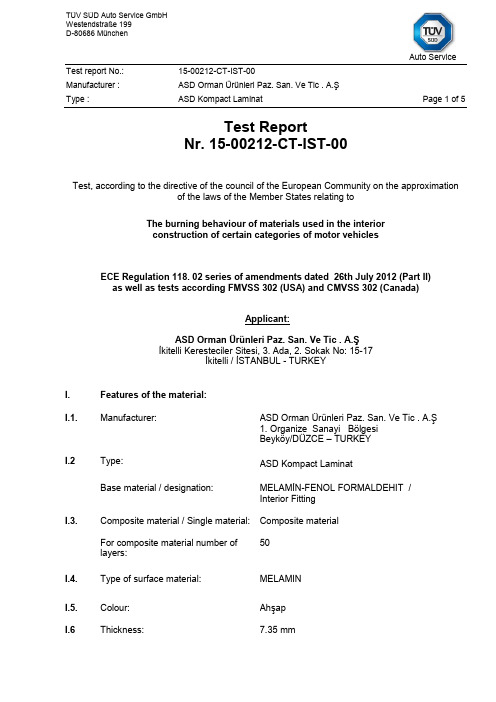
Manufacturer : ASD Orman Ürünleri Paz. San. Ve Tic . A.ŞType : ASD Kompact Laminat Page 1 of 5Test ReportNr. 15-00212-CT-IST-00Test, according to the directive of the council of the European Community on the approximationof the laws of the Member States relating toThe burning behaviour of materials used in the interiorconstruction of certain categories of motor vehiclesECE Regulation 118. 02 series of amendments dated 26th July 2012 (Part II) as well as tests according FMVSS 302 (USA) and CMVSS 302 (Canada)Applicant:ASD Orman Ürünleri Paz. San. Ve Tic . A.Şİkitelli Keresteciler Sitesi, 3. Ada, 2. Sokak No: 15-17İkitelli / İSTANBUL - TURKEYI.Features of the material:I.1.Manufacturer:ASD Orman Ürünleri Paz. San. Ve Tic . A.Ş1. Organize Sanayi BölgesiBeyköy/DÜZCE – TURKEYI.2Type:ASD Kompact LaminatBase material / designation: MELAMİN-FENOL FORMALDEHIT /Interior Fittingposite material / Single material:Composite material50For composite material number oflayers:I.4.Type of surface material: MELAMINI.5.Colour: AhşapI.6 Thickness: 7.35 mmManufacturer : ASD Orman Ürünleri Paz. San. Ve Tic . A.ŞType :ASD Kompact LaminatPage 2 of 5II. Test Record: II.1. Tests carried out:Testing of the burning behaviour of interior materials according to ECE- R 118.02☒ ECE- R 118.02 Annex 6 ☒ ECE- R 118.02 Annex 7 ☒ ECE- R 118.02 Annex 8☒ FMVSS 302 and CMVSS302II.2. Test results:☒The requirements concerning the burning behaviour according to ECE-R 118 Ap-pendix 6/ 8 are met. They were verified in☐ Horizontal directionECE-R 118.02 (Annex 6 ) FMVSS 302 and CMVSS 302☐ Vertical direction andECE-R 118.02 (Annex 8 )☒horizontal and vertical directionECE-R 118.02 ( Annex 6 and 8)The requirements concerning the melting behaviour according to ECE-R 118.02II.3.EnclosuresRefer to Measuring sheet burning behaviour Nr. ASD- ASD 1050 Laminat-00 dated 09.03.2015II.4. Place and date of the Test: Ankara (TR), 12.03.2015Manufacturer : ASD Orman Ürünleri Paz. San. Ve Tic . A.ŞType :ASD Kompact LaminatPage 3 of 5M. Savaş KARAKAYA ExpertII.5.Statement of conformity:The Measuring sheet burning behaviour as mentioned under No. II.3 and the type de-scribed therein are in compliance with the test specification mentioned above. The worst-case was selected in accordance with document “Preparation of Test Reports”.The test report may be reproduced and published in full and by the client only. It can be reproduced partially with the written permission of the test laboratory only.TÜV SÜD Auto Servic e is designated as a Technical Service (EU / ECE) by :Munich, 13.03.2015Manufacturer : ASD Orman Ürünleri Paz. San. Ve Tic . A.ŞType : ASD Kompact Laminat Page 4 of 5 ECE R-118.02 Annex 6 Horizontal burning behaviour:ECE R-118.02 Annex 7 Melting behaviour:Manufacturer : ASD Orman Ürünleri Paz. San. Ve Tic . A.ŞType : ASD Kompact Laminat Page 5 of 5 ECE R-118.02 Annex 8 Vertical burning behaviour:。
防火标准fmvss 302
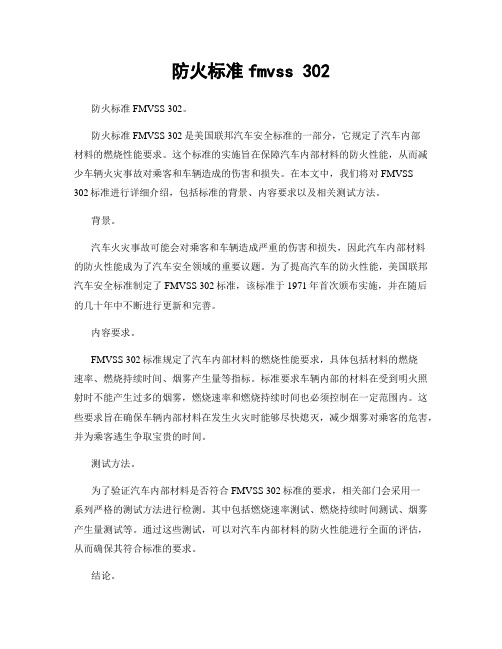
防火标准fmvss 302防火标准FMVSS 302。
防火标准FMVSS 302是美国联邦汽车安全标准的一部分,它规定了汽车内部材料的燃烧性能要求。
这个标准的实施旨在保障汽车内部材料的防火性能,从而减少车辆火灾事故对乘客和车辆造成的伤害和损失。
在本文中,我们将对FMVSS302标准进行详细介绍,包括标准的背景、内容要求以及相关测试方法。
背景。
汽车火灾事故可能会对乘客和车辆造成严重的伤害和损失,因此汽车内部材料的防火性能成为了汽车安全领域的重要议题。
为了提高汽车的防火性能,美国联邦汽车安全标准制定了FMVSS 302标准,该标准于1971年首次颁布实施,并在随后的几十年中不断进行更新和完善。
内容要求。
FMVSS 302标准规定了汽车内部材料的燃烧性能要求,具体包括材料的燃烧速率、燃烧持续时间、烟雾产生量等指标。
标准要求车辆内部的材料在受到明火照射时不能产生过多的烟雾,燃烧速率和燃烧持续时间也必须控制在一定范围内。
这些要求旨在确保车辆内部材料在发生火灾时能够尽快熄灭,减少烟雾对乘客的危害,并为乘客逃生争取宝贵的时间。
测试方法。
为了验证汽车内部材料是否符合FMVSS 302标准的要求,相关部门会采用一系列严格的测试方法进行检测。
其中包括燃烧速率测试、燃烧持续时间测试、烟雾产生量测试等。
通过这些测试,可以对汽车内部材料的防火性能进行全面的评估,从而确保其符合标准的要求。
结论。
防火标准FMVSS 302的实施对于提高汽车的防火性能具有重要意义,它可以有效减少火灾事故对乘客和车辆造成的伤害和损失。
因此,汽车制造商和相关部门应严格遵守该标准的要求,不断改进汽车内部材料的防火性能,为消费者提供更加安全可靠的汽车产品。
通过对防火标准FMVSS 302的介绍,相信读者对该标准有了更深入的了解。
在未来的汽车安全工作中,我们应该不断加强对防火性能的监管和检测,为消费者提供更加安全可靠的汽车产品,共同致力于减少汽车火灾事故的发生,保障人民生命财产安全。
汽车零部件阻燃标准
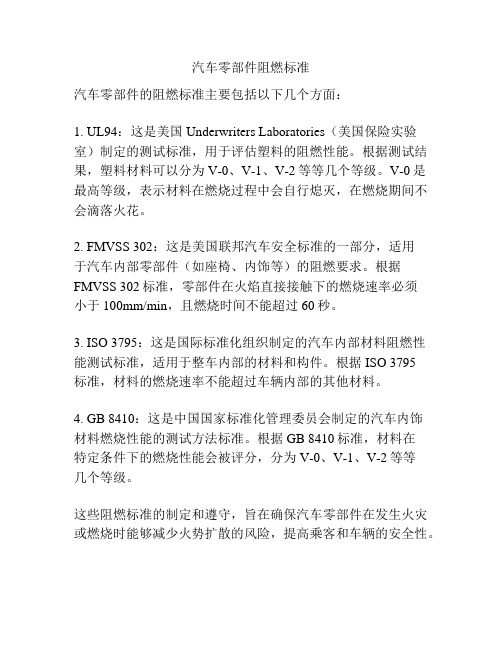
汽车零部件阻燃标准
汽车零部件的阻燃标准主要包括以下几个方面:
1. UL94:这是美国Underwriters Laboratories(美国保险实验室)制定的测试标准,用于评估塑料的阻燃性能。
根据测试结果,塑料材料可以分为V-0、V-1、V-2等等几个等级。
V-0是最高等级,表示材料在燃烧过程中会自行熄灭,在燃烧期间不会滴落火花。
2. FMVSS 302:这是美国联邦汽车安全标准的一部分,适用
于汽车内部零部件(如座椅、内饰等)的阻燃要求。
根据FMVSS 302标准,零部件在火焰直接接触下的燃烧速率必须
小于100mm/min,且燃烧时间不能超过60秒。
3. ISO 3795:这是国际标准化组织制定的汽车内部材料阻燃性
能测试标准,适用于整车内部的材料和构件。
根据ISO 3795
标准,材料的燃烧速率不能超过车辆内部的其他材料。
4. GB 8410:这是中国国家标准化管理委员会制定的汽车内饰
材料燃烧性能的测试方法标准。
根据GB 8410标准,材料在
特定条件下的燃烧性能会被评分,分为V-0、V-1、V-2等等
几个等级。
这些阻燃标准的制定和遵守,旨在确保汽车零部件在发生火灾或燃烧时能够减少火势扩散的风险,提高乘客和车辆的安全性。
fmvss302阻燃标准和v0对比

文章标题:深度解析FMVSS302阻燃标准与V0对比在当今社会中,汽车安全一直是人们关注的焦点。
而作为汽车安全的重要指标之一,阻燃性能更是备受关注。
在这篇文章中,我们将深度解析FMVSS302阻燃标准与V0对比,旨在帮助读者全面了解这两种标准并做出更加科学的选择。
一、FMVSS302阻燃标准1. 了解FMVSS302标准FMVSS302标准是美国联邦汽车安全标准的一部分,旨在规定车辆内部材料的阻燃性能要求。
具体来说,经过FMVSS302测试的材料在燃烧测试中不能产生持续的明火,并且其平均燃烧速度不能超过100mm/min。
这一标准的制定,有效地提高了汽车内部材料在火灾发生时的阻燃性能,从而减少了火灾造成的人身伤害和财产损失。
2. FMVSS302标准的优势FMVSS302标准的制定,无疑提高了汽车内部材料的阻燃性能,从而增加了车辆的安全性。
车辆内部采用符合FMVSS302标准的阻燃材料,一旦发生火灾,能够有效地延缓火势蔓延,给车内的乘客争取更多的逃生时间,降低伤亡事故的发生概率。
FMVSS302标准对于汽车安全具有重要意义。
二、V0阻燃等级1. 了解V0阻燃等级V0阻燃等级是指材料在垂直状态下进行燃烧测试时,在火焰移除后,试样不应该出现燃烧,且燃烧物体的时间应该小于10秒。
这一等级是电子电气设备领域常用的阻燃等级,用于评定材料在火灾发生时的燃烧性能。
2. V0阻燃等级的应用V0阻燃等级广泛应用于电子电气设备领域,例如电路板、插座、电源适配器等。
采用V0阻燃等级的材料能够有效降低电子电气设备在火灾发生时的燃烧风险,保障了设备的安全可靠运行。
三、FMVSS302与V0对比分析1. 不同领域的应用FMVSS302标准主要应用于汽车行业,旨在提高汽车内部材料的阻燃性能;而V0阻燃等级主要应用于电子电气设备领域,用于评定电子电气设备材料的阻燃性能。
两者的应用领域不同,因此在具体选择时需要根据实际情况进行考虑。
阻燃标准fmvss302

PASSENGER CARS, MULTIPURPOSE PASSENGER VEHICLES, TRUCKS AND BUSES EFFECTIVE — SEPTEMBER 1, 197236 FR 22965 12/2/71 (Issued 12/2)40 FR 14318-19 3/31/75 (Issued 3/17)40 FR 42746-7 9/16/75 (Issued 9/10)40 FR 56667-8 12/4/75 (Issued 11/28)63 FR 28922-57 5/27/98 (Issued 5/13/98)A63 FR 50995-1004 9/24/98 (Issued 9/21/98)S1.Scope. This standard specifies burn resistance requirements for materials used in the occupant compartments of motor vehicles.S2.Purpose. The purpose of this standard is to reduce the deaths and injuries to motor vehicle occupants caused by vehicle fires, especially those originating in the interior of the vehicle from sources such as matches or cigarettes.S3.Application. This standard applies to passenger cars, multipurpose passenger vehicles, trucks, and buses.S3A.Definitions. “Occupant compartment air space” means the space within the occupant compartment that normally contains refreshable air.S4.Requirements.S4.1The portions described in S4.2 of the following components of vehicle occupant compartments shall meet the requirements of S4.3: Seat cushions, seat backs, seat belts, headlining, convertible tops, arm rests, all trim panels including door, front, rear, and side panels, compartment shelves, head restraints, floor coverings, sun visors, curtains, shades, wheel housing covers; engine compartment covers, mattress covers, and any other interior materials, including padding and crash-deployed elements, that are designed to absorb energy on contact by occupants in the event of a crash.S4.1.1Reserved.S4.2Any portion of a single or composite material which is within 1/2 inch of the occupant compartment air space shall meet the requirements of S4.3.Effective: 5/27/99R–<S4.2 Any portion of a single or composite material which is within 13 mm of the occupant compartment air space shall meet the requirements of S4.3. >S4.2.1Any material that does not adhere to other material(s) at every point of contact shall meet the requirements of S4.3 when tested separately.S4.2.2Any material that adheres to other material(s) at every point of contact shall meet the requirements of S4.3 when tested as a composite with the other material(s). Effective: 5/27/99R–<S4.2.2 Any material that adheres to other materials at every point of contact shall meet the requirements of S4.3 when tested as a composite with the other material(s). >PASSENGER CARS, MULTIPURPOSE PASSENGER VEHICLES, TRUCKS AND BUSES Illustrative ExampleEffective: 5/27/99Illustrative ExampleR– <>C–<Material A has a non-adhering interface with material B and is tested separately. Part of material B is within 1/2 inch of the occupant compartment air space, and materials B and C adhere at every point of contact; therefore B and C are tested as a composite. The cut is in material C as shown, to make a specimen 1/2 inch thick. >S4.3(a) When tested in accordance with S5, material described in S4.1 and S4.2 shall not burn, nor transmit a flame front across its surface, at a rate of more than 4 inches per minute. However, the requirement concerning transmission of a flame front shall not apply to a surface created by the cutting of a test specimen for purposes of testing pursuant to S5.(b) If a material stops burning before it has burned for 60 seconds from the start of timing, and has not burned more than 2 inches from the point where timing was started, it shall be considered to meet the burn-rate requirement of S4.3 (a).PASSENGER CARS, MULTIPURPOSE PASSENGER VEHICLES, TRUCKS AND BUSESEffective: 5/27/99R–<Material A has a non-adhering interface with material B and is tested separately. Part of material B is within 13 mm of the occupant compartment air space, and materials B and C adhere at every point of contact; therefore, B and C are tested as a composite. The cut is in material C as shown, to make a specimen 13 mm thick.S4.3(a) When tested in accordance with S5, material described in S4.1 and S4.2 shall not burn, nor transmit a flame front across its surface, at a rate of more than 102 mm per minute. The requirement concerning transmission of a flame front shall not apply to a surface created by the cutting of a test specimen for purposes of testing pursuant to S5.(b) If a material stops burning before it has burned for 60 seconds from the start of timing, and has not burned more than 51 mm from the point where timing was started, it shall be considered to meet the burn-rate requirement of S4.3 (a). >S5.T est procedure.S5.1Conditions.S5.1.1The test is conducted in a metal cabinet for protecting the test specimens from drafts. The interior of the cabinet is 15 inches long, 8 inches deep, and 14 inches high. It has a glass observation. window in the front, a closable opening to permit insertion of the specimen holder, and a hole to accommodate tubing for a gas burner. for ventilation, it has a 1/2-inch clearance space around the top of the cabinet, ten 3/4-inch-diameter holes in the base of the cabinet, and legs to elevate the bottom of the cabinet by three-eighths of an inch, all located as shown in figure 1.S5.1.2Prior to testing, each specimen is conditioned for 24 hours at a temperature of 70_ F and a relative humidity of 50 percent, and the test is conducted under those ambient conditions.Effective: 5/27/99R–<S5.1.1 The test is conducted in a metal cabinet for protecting the test specimens from drafts. The interior of the cabinet is 381 mm long, 203 mm deep, and 356 mm high. It has a glass observation window in the front, a closable opening to permit insertion of the specimen holder, and a hole to accommodate tubing for a gas burner. For ventilation, it has a 13 mm clearance space around the top of the cabinet, ten holes in the base of the cabinet, each hole 19 mm in diameter and legs to elevate the bottom of the cabinet by 10 mm, all located as shown in Figure 1.S5.1.2Prior to testing, each specimen is conditioned for 24 hours at a temperature of 21° C, and a relative humidity of 50 percent, and the test is conducted under those ambient conditions. >S5.1.3The test specimen is inserted between two matching U-shaped frames of metal stock 1-inch wide and 3/8 of an inch high. The interior dimensions of the U-shaped frames are 2 inches wide by 13 inches long. APASSENGER CARS, MULTIPURPOSE PASSENGER VEHICLES, TRUCKS AND BUSESFIGURE 1PASSENGER CARS, MULTIPURPOSE PASSENGER VEHICLES, TRUCKS AND BUSES Effective: 5/27/99R– <>PASSENGER CARS, MULTIPURPOSE PASSENGER VEHICLES, TRUCKS AND BUSESspecimen that softens and bends at the flaming end so as to cause erratic burning is kept horizontal by supports consisting of thin, heat-resistant wires, spanning the width of the U-shaped frame under the specimen at 1-inch intervals. A device that may be used for supporting this type of material is an additional U-shaped frame, wider than the U-shaped frame containing the specimen, spanned by 10-mil wires of heat-resistant composition at 1-inch intervals, inserted over the bottom U-shaped frame.S5.1.4 A bunsen burner with a tube of 3/8-inch inside diameter is used. The gas adjusting valve is set to provide a flame, with the tube vertical, of 1 1/2 inches in height. The air inlet to the burner is closed.Effective: 5/27/99R–<S5.1.3 The test specimen is inserted between two matching U-shaped frames of metal stock 25 mm wide and 10 mm high. The interior dimensions of the U-shaped frames are 51 mm wide by 330 mm long. A specimen that softens and bends at the flaming end so as to cause erratic burning is kept horizontal by supports consisting of thin, heat-resistant wires, spanning the width of the U-shaped frame under the specimen at 25 mm intervals. A device that may be used for supporting this type of material is an additional U-shaped frame, wider than the U-shaped frame containing the specimen, spanned by 10-mil wires of heat-resistant composition at 25 mm intervals, inserted over the bottom U-shaped frame.S5.1.4 A bunsen burner with a tube of 10 mm inside diameter is used. The gas adjusting valve is set to provide a flame, with the tube vertical, of 38 mm in height. The air inlet to the burner is closed. >S5.1.5The gas supplied to the burner has a flame temperature equivalent to that of natural gas.S5.2Preparation of specimens.S5.2.1 Each specimen of material to be tested shall be a rectangle 4 inches wide by 14inches long, wherever possible. The thickness of the specimen is that of the single or composite material used in the vehicle, except that if the material’s thickness exceeds 1/2 inch, the specimen. is cut down to that thickness measured from the surface of the specimen closest to the occupant compartment air space. Where it is not possible to obtain a flat specimen because of surface curvature, the specimen is cut to not more than 1/2 inch in thickness at any point. The maximum available length or width of a specimen is used where either dimension is less than 14 inches or 4 inches, respectively, unless surrogate testing is required under S4.1.1.Effective: 5/27/99R–<S5.2.1 Each specimen of material to be tested shall be a rectangle 102 mm wide by 356 mm long, wherever possible. The thickness of the specimen is that of the single or composite material used in the vehicle, except that if the material’s thickness exceeds 13 mm, the specimen is cut down to that thickness measured from the surface of the specimen closest to the occupant compartment air space. Where it is not possible to obtain a flat specimen because of surface curvature, the specimen is cut to not more than 13 mm in thickness at any point. The maximum available length or width of a specimen is used where either dimension is less than 356 mm or 102 mm, respectively, unless surrogate testing is required under S4.1.1.> S5.2.2 The specimen is produced by cutting the material in the direction that provides the most adverse test results. The specimen is oriented so that the surface closest to the occupant compartment air space faces downward on the frame.S5.2.3Material with a napped or tufted surface is placed on a flat surface and combed twice against the nap with a comb having seven to eight smooth, rounded teeth per inch.S5.3 Procedure.(a)Mount the specimen so that both sides and one end are held by the U-shaped frame, and one end is even with the open end of the frame. where the maximum available width of aPASSENGER CARS, MULTIPURPOSE PASSENGER VEHICLES, TRUCKS AND BUSES specimen is not more than 2 inches, so that thesides of the specimen cannot be held in theU-shaped frame, place the specimen in positionon wire supports as described in S5.1.3, withone end held by the closed end of the U-shapedframe.(b)Place the mounted specimen in ahorizontal position, in the center of the cabinet.(c)With the flame adjusted according toS5.1.4, position the bunsen burner andspecimen so that the center of the burner tip isthree-fourths of an inch below the center of thebottom edge of the open end of the specimen.(d)Expose the specimen to the flame for 15seconds.(e)Begin timing (without reference to theperiod of application of the burner flame) whenthe flame from the burning specimen reaches apoint 11/2 inches from the open end of thespecimen.(f)Measure the time that it takes the flameto progress to a point 1 1/2 inches from theclamped end of the specimen. If the flame doesnot reach the specified end point, time itsprogress to the point where flaming stops.(g)Calculate the burn rate from the formulaB = 60 x D TWhere:B =Burn rate in inches per minute.D =Length the flame travels in inches, andT =Time in seconds for the flame to travelD inches.Effective: 5/27/99R–<S5.2.3 Material with a napped or tufted surface is placed on a flat surface and combed twice against the nap with a comb having seven to eight smooth, rounded teeth per 25 mm.S5.3 Procedure.(a)Mount the specimen so that both sides and one end are held by the U-shaped frame, and one end is even with the open end of the frame. Where the maximum available width of a specimen is not more than 51 mm, so that the sides of the specimen cannot be held in the U-shaped frame, place the specimen in position on wire supports as described in S5.1.3, with one end held by the closed end of the U-shaped frame.(b)Place the mounted specimen in a horizontal position, in the center of the cabinet.(c)With the flame adjusted according to S5.1.4, position the bunsen burner and specimen so that the center of the burner tip is 19 mm below the center of the bottom edge of the open end of the specimen.(d)Expose the specimen to the flame for 15 seconds.(e)Begin timing (without reference to the period of application of the burner flame) when the flame from the burning specimen reaches a point 38 mm from the open end of the specimen.(f)Measure the time that it takes the flame to progress to a point 38 mm from the clamped end of the specimen. If the flame does not reach the specified end point, time its progress to the point where flaming stops.(g)Calculate the burn rate from the formulaB = 60 xDTWhere:B =Burn rate in millimeters per minute.D =Length the flame travels in millimeters,andT =Time in seconds for the flame to travelD millimeters. >。
- 1、下载文档前请自行甄别文档内容的完整性,平台不提供额外的编辑、内容补充、找答案等附加服务。
- 2、"仅部分预览"的文档,不可在线预览部分如存在完整性等问题,可反馈申请退款(可完整预览的文档不适用该条件!)。
- 3、如文档侵犯您的权益,请联系客服反馈,我们会尽快为您处理(人工客服工作时间:9:00-18:30)。
§ 571.302 Standard No. 302; Flammability of interior materials.S1. Scope. This standard specifies burn resistance requirements for materials used in the occupant compartments of motor vehicles.S2. Purpose. The purpose of this standard is to reduce the deaths and injuries to motor vehicle occupants caused by vehicle fires, especially those originating in the interior of the vehicle from sources such as matches or cigarettes.S3. Application. This standard applies to passenger cars, multipurpose passenger vehicles, trucks, and buses.S3A. Definitions. Occupant compartment air space means the space within the occupant compartment that normally contains refreshable air.S4. Requirements.S4.1 The portions described in S4.2 of the following components of vehicle occupant compartments shall meet the requirements ofS4.3: Seat cushions, seat backs, seat belts, headlining, convertible tops, arm rests, all trim panels including door, front, rear, and side panels, compartment shelves, head restraints, floor coverings, sun visors, curtains, shades, wheel housing covers, engine compartment covers, mattress covers, and any other interior materials, including padding and crash-deployed elements, that are designed to absorb energy on contact by occupants in the event of a crash.S4.1.1 [Reserved]S4.2 Any portion of a single or composite material which is within 13 mm of the occupant compartment air space shall meet the requirements of S4.3.S4.2.1 Any material that does not adhere to other material(s) at every point of contact shall meet the requirements of S4.3 when tested separately.S4.2.2 Any material that adheres to other materials at every point of contact shall meet the requirements of S4.3 when tested as a composite with the other material(s).Material A has a non-adhering interface with material B and is tested separately. Part of material B is within 13 mm of the occupant compartment air space, and materials B and C adhere at every point of contact; therefore, B and C are tested as a composite. The cut is in material C as shown, to make a specimen 13 mm thick.S4.3(a) When tested in accordance with S5, material described in S4.1 and S4.2 shall not burn, nor transmit a flame front across its surface, at a rate of more than 102 mm per minute. The requirement concerning transmission of a flame front shall not apply to a surface created by cutting a test specimen for purposes of testing pursuant to S5.(b) If a material stops burning before it has burned for 60 seconds from the start of timing, and has not burned more than 51 mm from the point where the timing was started, it shall be considered to meet the burn-rate requirement of S4.3(a).S5.1 Conditions.S5.1.1 The test is conducted in a metal cabinet for protecting the test specimens from drafts. The interior of the cabinet is 381 mm long, 203 mm deep, and 356 mm high. It has a glass observation window in the front, a closable opening to permit insertion of the specimen holder, and a hole to accommodate tubing for a gas burner. For ventilation, it has a 13 mm clearance space around the top of the cabinet, ten holes in the base of the cabinet, each hole 19 mm in diameter and legs to elevate the bottom of the cabinet by 10 mm, all located as shown in Figure 1.S5.1.2 Prior to testing, each specimen is conditioned for 24 hours at a temperature of 21 °C, and a relative humidity of 50 percent, and the test is conducted under those ambient conditions.S5.1.3 The test specimen is inserted between two matching U-shaped frames of metal stock 25 mm wide and 10 mm high. The interior dimensions of the U-shaped frames are 51 mm wide by 330 mm long. A specimen that softens and bends at the flaming end so as to cause erratic burning is kept horizontal by supports consisting of thin, heat-resistant wires, spanning the width of the U-shaped frame under the specimen at 25 mm intervals. A device that may be used for supporting this type of material is an additional U-shaped frame,wider than the U-shaped frame containing the specimen, spanned by 10-mil wires of heat-resistant composition at 25 mm intervals, inserted over the bottom U-shaped frame.S5.1.4 A bunsen burner with a tube of 10 mm inside diameter is used. The gas adjusting valve is set to provide a flame, with the tube vertical, of 38 mm in height. The air inlet to the burner is closed.S5.1.5 The gas supplied to the burner has a flame temperature equivalent to that of natural gas.S5.2 Preparation of specimens.S5.2.1 Each specimen of material to be tested shall be a rectangle 102 mm wide by 356 mm long, wherever possible. The thickness of the specimen is that of the single or composite material used in the vehicle, except that if the material's thickness exceeds 13 mm, the specimen is cut down to that thickness measured from the surface of the specimen closest to the occupant compartment air space. Where it is not possible to obtain a flat specimen because of surface curvature, the specimen is cut to not more than 13 mm in thickness at any point. The maximum available length or width of a specimen is used where either dimension is less than 356 mm or 102 mm, respectively, unless surrogate testing is required under S4.1.1.S5.2.2 The specimen is produced by cutting the material in the direction that provides the most adverse test results. The specimen is oriented so that the surface closest to the occupant compartment air space faces downward on the test frame.S5.2.3 Material with a napped or tufted surface is placed on a flat surface and combed twice against the nap with a comb having seven to eight smooth, rounded teeth per 25 mm.S5.3 Procedure.(a) Mount the specimen so that both sides and one end are held by the U-shaped frame, and one end is even with the open end of the frame. Where the maximum available width of a specimen is not more than 51 mm, so that the sides of the specimen cannot be held in the U-shaped frame, place the specimen in position on wire supports as described in S5.1.3, with one end held by the closed end of the U-shaped frame.(b) Place the mounted specimen in a horizontal position, in the center of the cabinet.(c) With the flame adjusted according to S5.1.4, position the bunsen burner and specimen so that the center of the burner tip is 19 mm below the center of the bottom edge of the open end of the specimen.(d) Expose the specimen to the flame for 15 seconds.(e) Begin timing (without reference to the period of application of the burner flame) when the flame from the burning specimen reaches a point 38 mm from the open end of the specimen.(f) Measure the time that it takes the flame to progress to a point 38 mm from the clamped end of the specimen. If the flame does not reach the specified end point, time its progress to the point where flaming stops.(g) Calculate the burn rate from the formula:B = 60 × (D/T)Where:B = Burn rate in millimeters per minuteD = Length the flame travels in millimeters, andT = Time in seconds for the flame to travel D millimeters.[36 FR 22902, Dec. 2, 1971, as amended at 40 FR 14319, Mar. 31, 1975; 40 FR 42747, Sept. 16, 1975; 40 FR 56667, Dec. 4, 1975; 63 FR 28954, 28956, May 27, 1998; 63 FR 51003, Sept. 24, 1998]。
